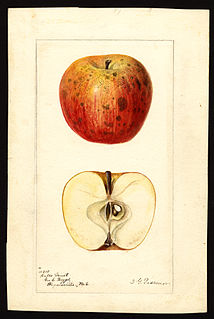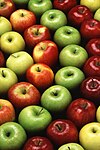
ɻhfigsg

A cooking apple or culinary apple is an apple that is used primarily for cooking, as opposed to a dessert apple, which is eaten raw. Cooking apples are generally larger, and can be tarter than dessert varieties. Some varieties have a firm flesh that does not break down much when cooked. Culinary varieties with a high acid content produce froth when cooked, which is desirable for some recipes. Britain grows a large range of apples specifically for cooking. Worldwide, dual-purpose varieties are more widely grown.

The Flower of Kent is a green cultivar of cooking apple. According to the story, this is the apple Isaac Newton saw falling to ground from its tree, inspiring his laws of universal gravitation. It is pear-shaped, mealy, and sub-acid, and of generally poor quality by today's standards. As its name suggests, this cultivar likely originated from Kent, England.

'Ralls Janet' is an apple cultivar that is also known by many other names. It has been used extensively in modern apple breeding, and has several commercially important offspring. It was grown at Monticello by Thomas Jefferson. It has been said that the name derives from Edmond-Charles Genet, a Frenchman who gave cuttings to Thomas Jefferson, who then passed them on to Virginia nurseryman Caleb Ralls, but this claim was not made until about 100 years after the apple became known and may not be accurate.

Antonovka, Антоновка, or Antonówka is a group of late-fall or early-winter apple cultivars with a strong acid flavor that have been popular in Russia as well as in Poland and Belarus. The most popular Russian variety is Common Antonovka, from which other cultivars derive. It was developed by pioneer Russian naturalist and plant breeder Ivan V. Michurin at his experimental orchard in the Tambov Oblast and introduced in 1888. Antonovka is famous for its unsurpassed strong and pleasant fruit aroma.

Blenheim Orange is a cultivar of apple. It was found at Woodstock, Oxfordshire near Blenheim in England in about 1740. It has been described as a cooking apple.

An apple is an edible fruit produced by an apple tree. Apple trees are cultivated worldwide and are the most widely grown species in the genus Malus. The tree originated in Central Asia, where its wild ancestor, Malus sieversii, is still found today. Apples have been grown for thousands of years in Asia and Europe and were brought to North America by European colonists. Apples have religious and mythological significance in many cultures, including Norse, Greek, and European Christian tradition.

Golden Noble is an old English cultivar of domesticated apple, which is especially used as a cooking apple, since it is resulting in a sweetish puree when cooked and is a good choice for apple sauce.

The 'Laxton's Superb' is an apple cultivar that was developed in England in 1897. It is a cross breed between Cellini and 'Cox's Orange Pippin' and is not ar cross between Wyken Pippin and Cox Orange Pippin. It is a British apple with a green color and a dull red flush. It is a firm-textured dessert apple. The fruit is well known for its sweet and aromatic taste which is likened to the parent species it is derived from, the 'Cox's Orange Pippin'. Density 0,82 g/cc, sugar 14,0%, acid 7,4 g/litre. Vitamin C 9mg/100g.

Bismarck is an apple cultivar. The fruit from the tree is used for cooking due to its sharp flavour and is most commonly pureed when cooking.

White Transparent is an early-season cultivar of apple which is usually used for cooking due to its sharp taste. It is sometimes said to be the same as 'Yellow Transparent', but 'Yellow Transparent' is sometimes described differently, with fine rather than coarse flesh, and a sub-acid rather than acid flavour. Weight 75 g, density 0.75 g/cc, sugar 10.5%, acid 11 g/litre, vitamin C 15 mg/100g.

King of the Pippins or Reine des Reinettes (French) is an old cultivar of domesticated apple originating from France, and is still used in its original form as well as in many derivative cultivars that have been bred from it. It was also formerly known as Golden Winter Pearmain, because of its ripening period at late fall.

Reinette du Canada or Canadian Reinette is, despite its name, an old French cultivar of domesticated apple. It is a reinette type of golden apple, with much russeting, which keeps shape in cooking and is mainly used for that purpose especially in apple strudel.

Wolf River is an American cultivar of domesticated apple, which originates from the shores of the Wolf River of Wisconsin, in the United States of America, known since 1875. The tree is exceptionally frost hardy and generally disease resistant, and thus keeps well in storage. The fruit usually ripens mid-September to early October. It is large, commonly weighing over a pound, and fairly sweet with a distinctive red and yellow appearance. It has many culinary uses, as it keeps its shape well when cooked.

Liveland Raspberry or Lowland Raspberry is an old cultivar of domesticated apple, first recorded before 1870, that originated from the Livland Governorate of eastern Europe and was introduced into the United States of America in 1883. It is a very early ripening apple.
Wyken Pippin is an old cultivar of domesticated apple originating in the Netherlands, or have originated in the garden of the Wyken Manor house in England from a seedling that was sourcing back to the Netherlands or Belgium, possibly in the early 1700s. It has several other names including 'Alford Prize' and 'Pheasant's Eye'.

'Winter Banana' is an apple cultivar with high-quality fruit used for fresh eating. The fruit is large, with smooth yellow skin that shows bruises more than red apples do. The flesh is rather coarse textured, moderately soft, sweet and aromatic. Sugar 12.5%, acid 7g/litre, vitamin C 12mg/100g.

Dumelow's Seedling is a cultivar of domesticated apple that originated at Shackerstone in Leicestershire where it was grown by Richard Dumeller in 1800. It is known by many other names including 'Dumelow's Crab', 'Wellington', 'Doncklaer', 'Beauty', and 'Belle de Vennes'. The fruit is not ready for harvest until October, being one of the last of the season, and keeps well into the next year. Though inferior for use as a dessert apple it cooks well and in early-20th century England was one of the most valuable varieties of cooking apple.


















